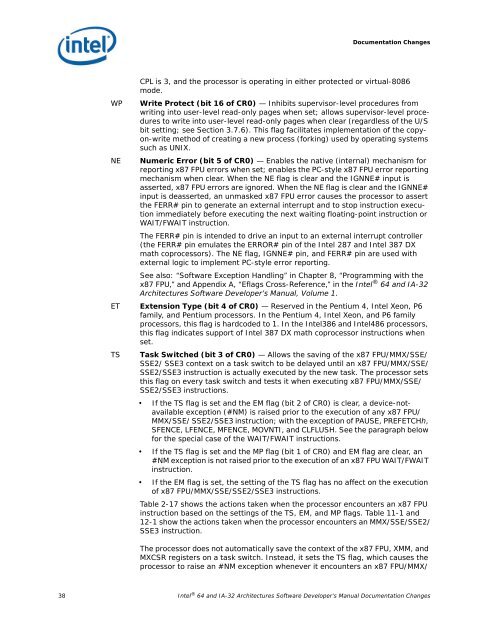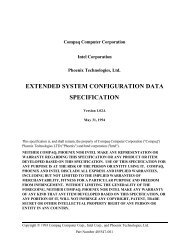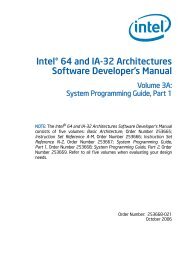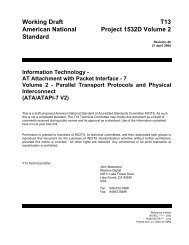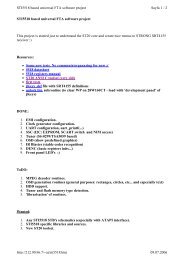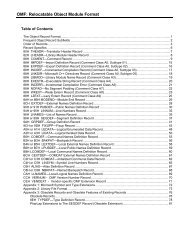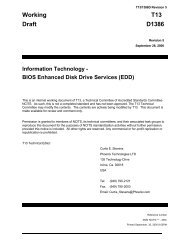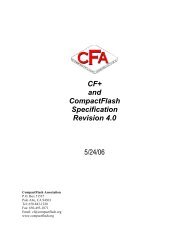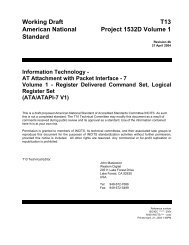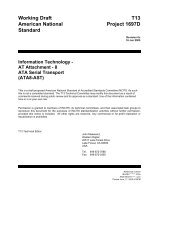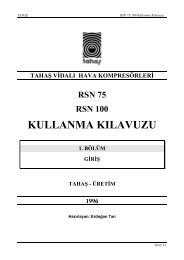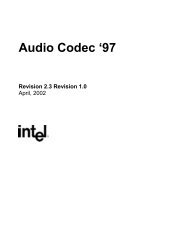Intel 64 and IA-32 Architectures Software Developer's Manual
Intel 64 and IA-32 Architectures Software Developer's Manual
Intel 64 and IA-32 Architectures Software Developer's Manual
Create successful ePaper yourself
Turn your PDF publications into a flip-book with our unique Google optimized e-Paper software.
Documentation Changes<br />
WP<br />
NE<br />
ET<br />
TS<br />
CPL is 3, <strong>and</strong> the processor is operating in either protected or virtual-8086<br />
mode.<br />
Write Protect (bit 16 of CR0) — Inhibits supervisor-level procedures from<br />
writing into user-level read-only pages when set; allows supervisor-level procedures<br />
to write into user-level read-only pages when clear (regardless of the U/S<br />
bit setting; see Section 3.7.6). This flag facilitates implementation of the copyon-write<br />
method of creating a new process (forking) used by operating systems<br />
such as UNIX.<br />
Numeric Error (bit 5 of CR0) — Enables the native (internal) mechanism for<br />
reporting x87 FPU errors when set; enables the PC-style x87 FPU error reporting<br />
mechanism when clear. When the NE flag is clear <strong>and</strong> the IGNNE# input is<br />
asserted, x87 FPU errors are ignored. When the NE flag is clear <strong>and</strong> the IGNNE#<br />
input is deasserted, an unmasked x87 FPU error causes the processor to assert<br />
the FERR# pin to generate an external interrupt <strong>and</strong> to stop instruction execution<br />
immediately before executing the next waiting floating-point instruction or<br />
WAIT/FWAIT instruction.<br />
The FERR# pin is intended to drive an input to an external interrupt controller<br />
(the FERR# pin emulates the ERROR# pin of the <strong>Intel</strong> 287 <strong>and</strong> <strong>Intel</strong> 387 DX<br />
math coprocessors). The NE flag, IGNNE# pin, <strong>and</strong> FERR# pin are used with<br />
external logic to implement PC-style error reporting.<br />
See also: “<strong>Software</strong> Exception H<strong>and</strong>ling” in Chapter 8, “Programming with the<br />
x87 FPU,” <strong>and</strong> Appendix A, “Eflags Cross-Reference,” in the <strong>Intel</strong> ® <strong>64</strong> <strong>and</strong> <strong>IA</strong>-<strong>32</strong><br />
<strong>Architectures</strong> <strong>Software</strong> Developer’s <strong>Manual</strong>, Volume 1.<br />
Extension Type (bit 4 of CR0) — Reserved in the Pentium 4, <strong>Intel</strong> Xeon, P6<br />
family, <strong>and</strong> Pentium processors. In the Pentium 4, <strong>Intel</strong> Xeon, <strong>and</strong> P6 family<br />
processors, this flag is hardcoded to 1. In the <strong>Intel</strong>386 <strong>and</strong> <strong>Intel</strong>486 processors,<br />
this flag indicates support of <strong>Intel</strong> 387 DX math coprocessor instructions when<br />
set.<br />
Task Switched (bit 3 of CR0) — Allows the saving of the x87 FPU/MMX/SSE/<br />
SSE2/ SSE3 context on a task switch to be delayed until an x87 FPU/MMX/SSE/<br />
SSE2/SSE3 instruction is actually executed by the new task. The processor sets<br />
this flag on every task switch <strong>and</strong> tests it when executing x87 FPU/MMX/SSE/<br />
SSE2/SSE3 instructions.<br />
• If the TS flag is set <strong>and</strong> the EM flag (bit 2 of CR0) is clear, a device-notavailable<br />
exception (#NM) is raised prior to the execution of any x87 FPU/<br />
MMX/SSE/ SSE2/SSE3 instruction; with the exception of PAUSE, PREFETCHh,<br />
SFENCE, LFENCE, MFENCE, MOVNTI, <strong>and</strong> CLFLUSH. See the paragraph below<br />
for the special case of the WAIT/FWAIT instructions.<br />
• If the TS flag is set <strong>and</strong> the MP flag (bit 1 of CR0) <strong>and</strong> EM flag are clear, an<br />
#NM exception is not raised prior to the execution of an x87 FPU WAIT/FWAIT<br />
instruction.<br />
• If the EM flag is set, the setting of the TS flag has no affect on the execution<br />
of x87 FPU/MMX/SSE/SSE2/SSE3 instructions.<br />
Table 2-17 shows the actions taken when the processor encounters an x87 FPU<br />
instruction based on the settings of the TS, EM, <strong>and</strong> MP flags. Table 11-1 <strong>and</strong><br />
12-1 show the actions taken when the processor encounters an MMX/SSE/SSE2/<br />
SSE3 instruction.<br />
The processor does not automatically save the context of the x87 FPU, XMM, <strong>and</strong><br />
MXCSR registers on a task switch. Instead, it sets the TS flag, which causes the<br />
processor to raise an #NM exception whenever it encounters an x87 FPU/MMX/<br />
38 <strong>Intel</strong> ® <strong>64</strong> <strong>and</strong> <strong>IA</strong>-<strong>32</strong> <strong>Architectures</strong> <strong>Software</strong> Developer’s <strong>Manual</strong> Documentation Changes


